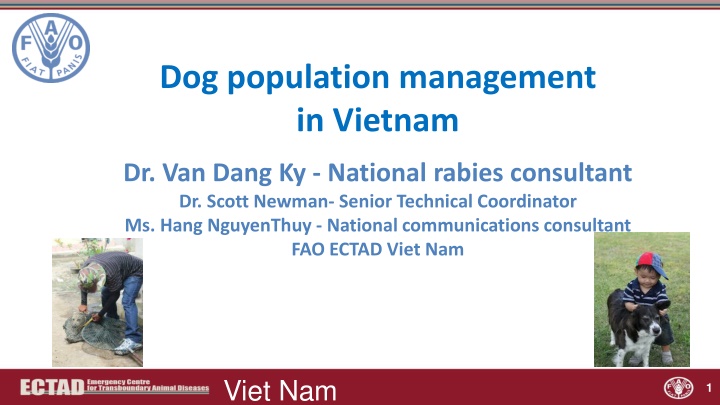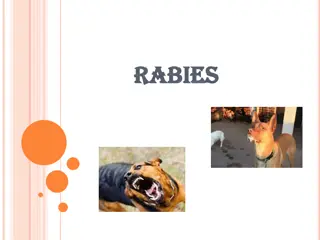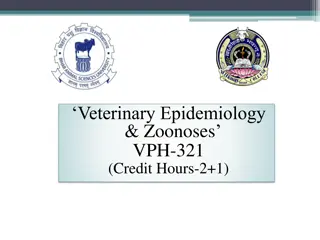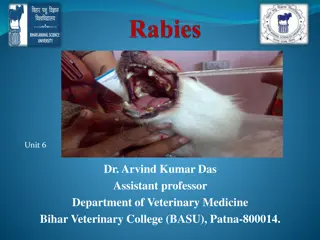Dog Population Management and Rabies Control in Vietnam
Vietnam faces challenges in managing its dog population and controlling rabies, with a significant number of unvaccinated roaming dogs posing risks to public health. The country has seen a rise in rabies cases, predominantly caused by dog bites, leading to a substantial annual death toll. Efforts are being made to improve dog registration and vaccination rates to better control rabies transmission.
Download Presentation

Please find below an Image/Link to download the presentation.
The content on the website is provided AS IS for your information and personal use only. It may not be sold, licensed, or shared on other websites without obtaining consent from the author.If you encounter any issues during the download, it is possible that the publisher has removed the file from their server.
You are allowed to download the files provided on this website for personal or commercial use, subject to the condition that they are used lawfully. All files are the property of their respective owners.
The content on the website is provided AS IS for your information and personal use only. It may not be sold, licensed, or shared on other websites without obtaining consent from the author.
E N D
Presentation Transcript
Dog population management in Vietnam Dr. Van Dang Ky - National rabies consultant Dr. Scott Newman- Senior Technical Coordinator Ms. Hang NguyenThuy - National communications consultant FAO ECTAD Viet Nam https://encrypted-tbn3.gstatic.com/images?q=tbn:ANd9GcRbFUcS5sGGN5GENXAi7DpAC0BXJh7aFsN4Z_QVkyCFbzuVcF_QMQ Viet Nam 1
Contents Overview of dog management in Vietnam Rabies situation Activities prevent and control rabies in Viet Nam Support by intentional organizations in rabies prevention and control Lessons learned Viet Nam 2
Dog management in Vietnam Domestic dogs population distributed in North, Central & South VN Higher densities in lowland provinces, cities, towns and townships Majority of dogs are native & raised for protecting homes or property, and for consumption (dog meat) A smaller number of dogs are imported & raised in urban cities Normally, a family keeps one dog, but somtimes 3 or 4 and up to 8 in more rural locations - many families have both dog and cat. Dog population in VN estimated to be approximately 8- 9 million but a more accurate population count is needed Viet Nam 3
Dog management in Vietnam The management of dog population is quite poor at all levels Most dogs are free-ranging & roaming, not kept on chains or leashes Roaming dogs do not have muzzles Most dogs are not vaccinated against rabies Most dogs are not registered with local veterinary services resulting in the dog census not obtaining accurate dog population numbers Some big cities (HCMC, Hanoi and Hai Phong) have conducted dog census, and made efforts to have most dogs registered so they have more accurate and updated figures for dog (and cat) populations Viet Nam 4
Situation of Rabies in Viet Nam Rabies has existed and circulated in Vietnam for many years. It occurs at any time in the year. Figure: Rabies incidence risk in Viet Nam In 1990s- rabies declining; 2004 - today rabies increasing Rabies in people is almost exclusively caused by dog bites According to the Ministry of Health report from the rabies prevention and control committee: >300,000 people suffered dog bites & are given vaccine yearly Human deaths from rabid dog bites is on the rise (average per year of about 100 people die of rabies) Viet Nam 5
The Document of Government and MARD Dog management is regulated in: Decree 05 /2007/N CP/ on rabies control and prevention of rabies in animals issued by Prime Minister on 9 January 2007 (Article 6 provides for management of dog) Ministry of Agriculture and Rural Development issued Circular guidelines on rabies prevention No:48/2009/TT- BNNPTNT dated 04/08/2009 (Article 4 of the guidelines on the management of dogs) Animal Health Law will be signed in May, 2015 Viet Nam 6
Rabies situation in Vietnam from 2008 to present Infected Provinces Infected Districts Infected Communes Year Rabies cases 2008 2009 2010 2011 2012 2013 5 4 6 7 8 11 7 8 14 9 19 15 28 10 42 14 34 36 110 25 150 100 268 272 2014 128 12 18 42 Source: Epidemiology Division, Department of Animal Health, 2014 Viet Nam 7
Situation of Rabies in Viet Nam Most cases occur in the northern mountainous provinces Most outbreaks were detected in humans before dogs Since dogs are not managed carefully, numbers of dog cases may not be accurately counted 2 rabies vaccination rounds annually: April-May and Sept-October In urban areas, more than 80% of pets was vaccinated while in rural and remote areas, vaccination percentage was less than 50%. Most Important Feature in Viet Nam: People not fully aware of the dangerous nature of rabies nor proper dog management practices including dog vaccination Viet Nam 8
Main challenges for controlling human & canine cases in Viet Nam 1. People do not think it is important to vaccinate their dogs 2. Difficult to reach desired 70% vaccination rate of dog population 3. As most dogs roam in large numbers with other dogs, one infected dog can easily spread disease to other dogs in the group 4. Rabies vaccination too expensive for some families to treat their dogs 5. People do not get post-exposure vaccination if they are bitten because: a) they do not think it is necessary, b) they do not have access to medical facilities with the vaccine, or c) it is too expensive Viet Nam 9
National Program on Rabies prevention & control (2011-2015) Overall: National Program - Minster of MARD Government budget: $11.6 million USD ( 233.114 billion VND) Central Government: $1.3 million USD of which MARD 0.8 million USD & MOH: 0.5 million USD Local Government: $10.3 millions USD of which MARD 6.5 million USD & MOH 3.8 million USD Privates/dogs owners: vaccine and vaccination fees MOET (education), MIC (communication); MPS (Pub. Security), MARD & MOH Institutions Viet Nam 10
The National Program: Objectives Increase public awareness of the risk of rabies and methods for rabies control & prevention Improve MARD & MOH rabies monitoring & surveillance systems 80% of dog population will be managed 80% of dog population will be vaccinated against rabies 70% of Provinces will be free from rabies The rabies case fatility rate (CFR) will decrease about 30% compared to the average CFR in period 2006-2010 Viet Nam 11
Major Support Provided by International Organizations on Rabies Prevention & Control ASEAN countries nominated Vietnam as lead for South- East Asia Rabies Strategy (SEARS) to control & eliminate rabies by 2020 In 2012, FAO funded Knowledge-Attitude-Practices project aiming to better understand the ecological characteristics of dogs and minimize the risk rabies in humans and animals Identify difficulties and gaps in the rabies policies - Phu Tho province the pilot province Evaluate two models for improved dog registration at local - village level Viet Nam 12
Key findings of KAP research Knowledge and Attitude vs Practices for prevention 96% are aware of rabies Most people leave their dogs roaming & unchained increasing risk of exposure 90% are aware that dogs are the main reservoir of rabies transmission to humans Only 8 % report dog bites or suspected rabid dogs 94 % know that dog rabies can be prevented by vaccination Only 24 % vaccinate their dogs for rabies 83 % know that human rabies can be prevented by vaccinating dogs Only 32.2% register their dogs Viet Nam 13
Dog registration trial Model 1: Village leader go dog owners to collect data for dog population and provide the registration certificate for the dog owners. In Cat Tru commune : 396 / 607 dog households (65.24 %) registered 518 dogs were registered ( 39 households / day). In Huong Lung commune : 665 / 865 dog households (78.9 %) 1280 dogs were registered (67 households / day) Summary : 1.061 (72.8 %) dog household registered 1.798 dogs (81.6 %) were registered Model 2 Dog owners go to register for dog keeping with Village header. Village header provide the registration certificate to the dog owners. B n G t commune: 11/193 dog households ( 5,70% ) registered 11 dogs were registered (01 household /day). Van Phu commune: 306/995 dog households (24,82% ) registered 527 dogs were registered ( 31 household /day) Sumary Vi t Tri city : 317 (28.9%) dog household registered 538 (32.2%) were registered Viet Nam 14
Major Support Provided by International Organizations on Rabies Prevention & Control May 2013: FAO CMC-AH mission team deployed to support the Government of Viet Nam to respond to the rabies situation in the country and recommend interventions for improved rabies prevention and control In 2014: Memorandum of Understanding (MOU) signed between the MARD, MOH and WSPA to foster & further strengthen the cooperation information, exchange of expertise & coordinate a program to build the overall prevention of rabies at national level through exchange of Viet Nam 15
Major Support Provided by International Organizations on Rabies Prevention & Control 2013-2015: FAO TCP Project to Strengthening institutional capacity for and Improving inter-sectoral collaboration, coordination, and communication for effective prevention and control rabies in Vietnam - US$ 386,000 + in kind + complimentary donor (WSPA) funding 2013 & 2014: OIE donated 200,000 & 500,000 doses of rabies vaccine for emergency use Viet Nam 16
FAO Project Participants from FAO, Ministry of Health, Ministry of Agriculture and Rural Development, Provincial Departments of Agriculture and Rural Development, and Department of Health in Son La, Yen Bai, Phu Tho and Thai Nguyen province 1. An instructor showing how to capture, vaccinate and put a collar mark on a dog Viet Nam 17
Activities of the FAO TCP Rabies Project 3 Training of trainers (TOT) courses for dog catching, vaccination, and rabies prevention & control - 75 Participants Trainings coordinated between DAH and FAO 6 policy advocacy meetings in the 6 District models in two pilot project provinces (Phu Tho and Thai Nguyen) 13 communes levels advocacy meetings in the 6 districts in model of 2 provinces (Phu Tho and Thai Nguyen province). Cross-sectoral Communication collaboration amongst FAO, OIE, WSPA, DAH, GDPM, WHO Posters, leaflets, world rabies day fact sheets and materials materials produced via Viet Nam 18
Policy and Coordination Workshop Communication Workshop Training of Trainers (TOT) Guideline for trainers Viet Nam 19
Recent Dog Management Improvements 35 Provinces have improved management practices: dogs chained up & annual registration & vaccinations 22 Provinces implemented free roaming dog captures Ongoing pilot approach to focused dog registration & vaccination program with increased public awareness in 18 communes in 6 districts of the two provinces models (Phu Tho and Thai Nguyen province) Pilot grade school rabies communication training ongoing Rabies surveillance in Phu Tho & Dong Nai province-CDC Viet Nam 20
Lessons Learned KAP survey necessary to understand what decsions people make and why Central, Provincial and Local government support (human & financial) and committment is necessary to succeed Behavior Change Communication for proper dog management is important Local enforcement of legislation & regulations is important An effective rabies prevention, control, and response program requires close collaboration among MARD & MOH & MOET Viet Nam 21
ONE HEALTH the World Rabies Day in Hoa Binh province Viet Nam 22
THANK YOU FOR YOU ATTENTION! Viet Nam 23























